Friends of Woodthorpe Grange Park 2023
Return
Sherwood, Nottingham Historical Timeline
1609: The core of the Woodthorpe Estate was marked out in a 1609 Crown Survey map of Sherwood Forest as an enclosed field that was occupied by George Hutchinson, a freeholder of the land.
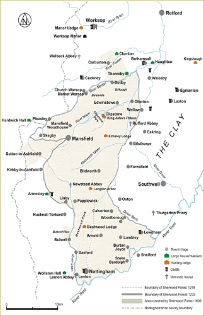
1609 Crown Survey Map of Sherwood Forest. To view an enlarged image, click on the above illustration
Sherwood is built on land that was originally the southern tip of the ancient Sherwood Forest. Until the 18th Century it was open common land used by the people of Nottingham for grazing animals. People considered it difficult and even dangerous to cross the open space of Nottingham Lings (the area now known as The Forest) because of the rough, unmade roads bordered by dense vegetation which made it ‘a lurking place for all sorts of undesirable folk’.
1774: Woodthorpe House the oldest building in Sherwood. Over the years the house had connections with many prominent Nottingham families including Sir William Hugh Tomasson (1858-1922), at one time Nottinghamshire’s Chief Constable, who moved there in 1898. The house was lived in by the Tomasson family until the 1930s. In 1940 during the Second World War Woodthorpe House was requisitioned by the War Office used firstly as a camp for German and Italian prisoners of war and later as the Regimental Headquarters for the 161 and 172 Mixed Heavy Anti-Aircraft Regiments two artillery regiments that were formed in August 1942 and later disbanded in April 1945. After the War in 1949 the Sherwood Community Association gained use of the house and eventually it became the Sherwood Community Centre.
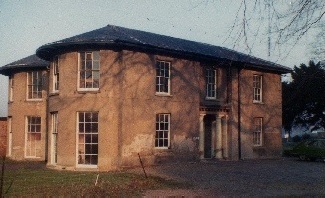
Woodthorpe House
1792 Enclosure Act: Land Lot 188 was allotted by the Enclosure Commissioners of Basford to Henry Cavendish Esquire the 6th Duke of Devonshire for Tithes, and in the same area William Rawson and William Dams were allotted land lot’s 189 and 190 respectively.

To read an excerpt from the Nottingham Date Book covering the 1792 Enclosure Act, click on the above map

6th Duke of Devonshire
The 6th Duke of Devonshire was known as the Bachelor Duke as he never married and on his death at Hardwick Hall in 1858 he was succeeded as Duke of Devonshire by his first cousin once removed, William Cavendish the second Earl of Burlington.
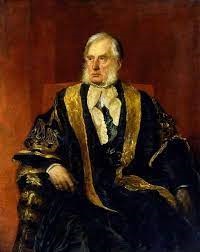
7th Duke of Devonshire
The seventh Duke of Devonshire, William Cavendish was the eldest son of George Cavendish, 1st Earl of Burlington, third son of William Cavendish, fourth Duke of Devonshire and Lady Charlotte Boyle, daughter of Richard Boyle, 3rd Earl of Burlington. His mother was the Honourable Louisa O’Callaghan the 1st Baron Lismore.


To read a related article concerning mixed Royal Artillery anti-aircraft (AA) regiments, click on the left hand illustration.


6th Duke of Devonshire’s Coat of Arms

7th Duke of Devonshire’s Coat of Arms
Hardwick Hall, Derbyshire
1800's: Parcels of land were sold off for building development and many of the allotments were lost, though some, such as Bagthorpe Gardens, remain in existence today. The area developed rapidly during the period after 1860, and included factories, engineering works and housing for the professional classes and better off working-class people who wanted to move out of the overcrowded city.
1814: Sherwood was a settlement of just a few dwellings.
1841: Sherwood had developed into a sizeable hamlet. According to the Census for that year, local inhabitants were working as lace makers, framework knitters, servants and agricultural labourers.
1840s: Eliza Litt and Eliza Tunnicliffe, both teachers established an academy for girls in Sherwood Grange, a house that is still there at the corner of Hood Street and Winchester Street and is now the Sherwood Chiropractor Clinic
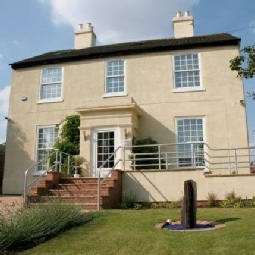
1840s: Sherwood Grange, former academy for girls, now Sherwood Chiropractor Clinic
May 1871: Alfred Pogson, who owned the 40-acre farm of grass and arable land, bordered by Mansfield Road and Scout Lane (now Woodthorpe Drive) put the land for sale at an auction, where the auctioneer, William Whitehead, produced a sketch map of the area on which it was strongly suggested a 50ft wide road should be built from Mansfield Road right through the heart of what is now Woodthorpe Park.
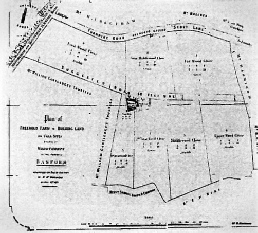
To View an enlarged version of the 1871 sketch map, click on the above illustration.

1846; Sherwood Inn..
1846: The Sherwood Inn was opened although there had been a brewhouse and beerhouse on the site for some years.


Arno Vale House
To read a biography of Henry Ashwell,
click on the above image
1874: Woodthorpe Grange is built. It is here where Henry Ashwell lived with his wife Sarah and two daughters, Mary and Frances, along with two nieces and four servants.
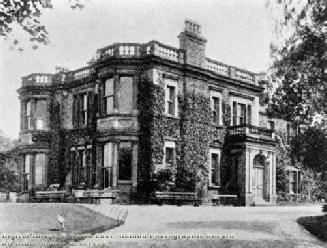
Woodthorpe Grange
1867: Nottingham Patent Brick Company was formed when William Burgass and Edward Gripper amalgamated all their brick works at Mapperley and Carlton. The three brick yards at Thorneywood and Mapperley Hills survived two world wars and a shrinking market for bricks. Thorneywood brick works finally closed in 1967. Brick production finally ended in 1969 and the last of the kilns and chimneys were demolished in 1970.
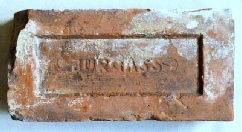
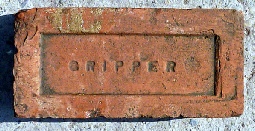
Burgass
Gripper


Nottingham Patent Brick Company, Mapperley
1877: The Borough of Nottingham extends its boundaries to include, amongst others, Basford, Carrington and Sherwood. It had taken only 50 years for the hamlet of Sherwood to become a suburb of Nottingham. In the same year Pennhome almshouses for ladies of reduced fortune on Haydn Road was opened.

1877: Boundary, Woodthorpe Drive. For more historical information, click on the above illustration.

1877: Pennhome almshouses

1878: Sherwood Board is opened. For more historical information, click on the illustration
1878: Sherwood Board School:
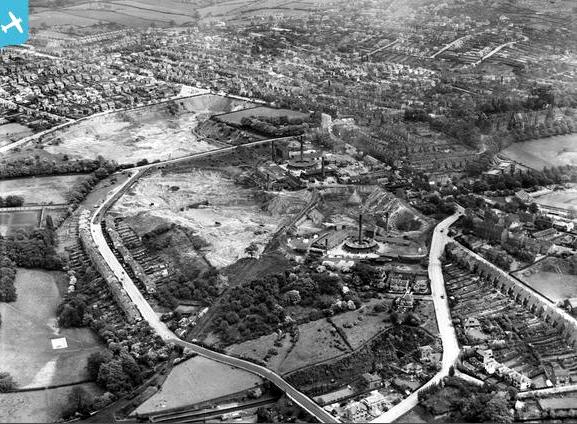
1938: Aerial view of the Nottingham Patient Brick Works, Mapperley
1881: The Woodthorpe Estate was extended in 1881 when Ashwell bought the small brickworks on Scout Lane (Woodthorpe Drive) from John Harrison for £655, and converted it into the rockery/dell gardens, which are now part of the park.

Dell Garden, Woodthorpe Grange Park
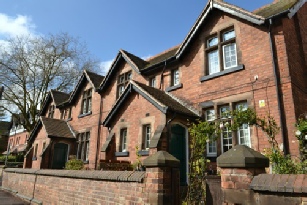
1882-83: Cullen’s Court. Mansfield Road.
1882 - 83: Cullen’s Court, on the corner of Mansfield Road and Bingham Road. A memorial to James Cullen, hence the title Cullen’s Court.
1884: January, 126 acres of land was purchased from the Vicar of Basford, Rev. Harry Rogers Pitman by the Nottingham Corporation for £25,475. (Today’s Nottingham City Hospital campus).
1885: A group of local businesspeople formed a project to make a new railway running more directly to Daybrook; as well as greatly shortening the journey for the growing residential passenger business, the line would link in important brickworks at Thorneywood and Mapperley.
1886: A Parliamentary Bill is passed which gave the go ahead for the construction of the Nottingham Suburban Railway.
1887: At a cost of f £262,500 work begins on the construction of the Nottingham Suburban Railway. The chief design engineer was Edward Parry and the architect was Thomas Chambers Hine. In the same year Sherwood Methodist Chapel was opened.

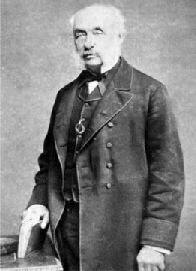
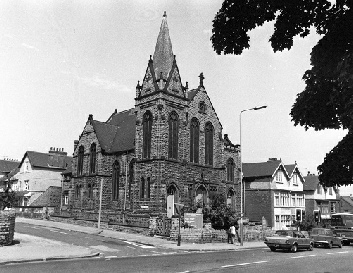
Edward Parry
T. C. Hine
Sherwood Methodist Church
1889: Nottingham Suburban Railway’s Sherwood Station was opened on the 2nd December where the line ran right across and under the Ashwell estate. Although compensated financially, Ashwell was not happy about Nottingham Suburban Railway crossing right across his estate. It is recorded that he insisted that Ashwell’s Tunnel, named after him, was lengthened by 10 yards so that it would not disturb the hay ricks in his farmyard at Woodthorpe Farm.
To read the full transcript of the report of the Opening of the Nottingham Suburban Railway that was published in the Nottingham Evening Post on the same date, click on the underlined title.


Sherwood Station
Ashwell Tunnel
From 1889 until 1900 the line enjoyed its heyday and was certainly at its busiest. The trams had not yet arrived on the scene, let alone the motorcar, and for just over 10 years the line was the direct route to the city of Nottingham which it set out to be.
1889:The foundation stone for Robinson’s almshouses is laid.

1889: Robinson’s Almshouses: For more historical information, click on the above image
1891: Henry Ashwell sells Woodthorpe Grange to Edward Parry. In the same year Bagthorpe Prison on Perry Road was opened for the reception of 200 males. In 1894 a new block opened to accommodate 40 female prisoners. In 1930, the prison closed and was reopened as a Borstal institution in 1932. In 1950 it reverted back to being a prison, but this time as a maximum security prison.

Bagthorpe/Nottingham Prison. For more historical information, click on the above image.
15th July 1892: The Bagthorpe Isolation Hospital (Heathfield Hospital) is opened by the Mayor of Nottingham. In attendance was Miss Dickinson, the hospitals first Matron and Dr Wynne, the Assistant Medical Officer.

Bagthorpe Isolation Hospital:
For more historical facts and information, click on the above image
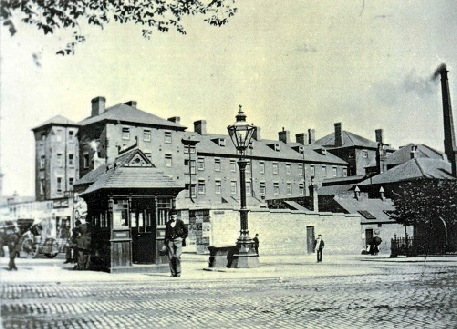
1893: Parliament gives approval for the London extension to the Manchester, Sheffield and Lincolnshire Railway -The Great Central Railway.
The construction of the Nottingham Victoria Railway Station occupied a side of some 13 acres; it involved the excavation of 600,000 cubic yards of sandstone rock, as well as the demolishing of 1,300 houses, 20 public houses and the Nottingham Union Workhouse.
1895: Union Workhouse, York Street, Nottingham

31st March, 1896: 64 acres of vacant land at Bagthorpe was purchased to build the new workhouse and infirmary.
March 1897: The Cedars Hospital on Mansfield Road is opened with 20 beds as a recuperative hospital for patients recovering from surgery.
17th April, 1899: The foundation stone to the Bagthorpe Workhouse and Infirmary is laid.
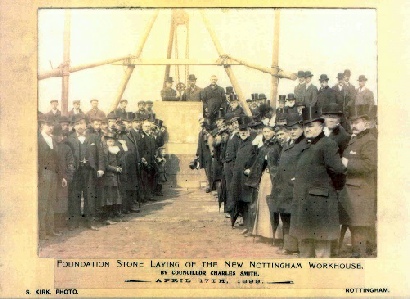
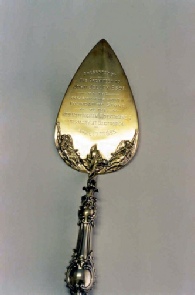
Ceremonial Trowel used to lay the foundation stone to the Bagthorpe Workhouse and Infirmary.

2013: Foundation Stone
24th May, 1900: Nottingham Victoria Station is opened. With the opening of Nottingham Victoria station in 1900 and only 11 years after itself being open for traffic, the Suburban Railway at a stroke lost most of its importance and from then on fewer stopping passenger trains used the line on account of the direct route to Basford afforded by the Great Central Line and the Junctions at Bagthorpe. Also, in the same year Sherwood Tram depot was built.
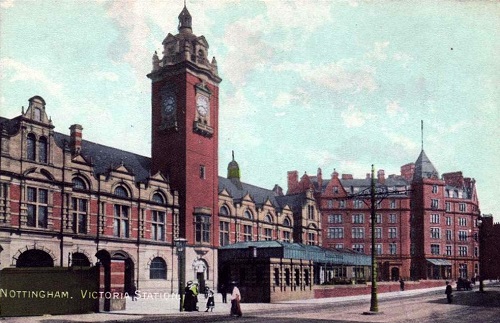

Nottingham Victoria Railway Station
Sherwood Tram Depot
1901: The electric tram appeared in Nottingham and one of the first routes in operation was from a point close to Sherwood Station on Mansfield Road running past the new Nottingham Victoria Railway Station.

1901: The first electric tram outside Sherwood Tram Depot. For more historical information, click on the above image.
Wednesday 18th March, 1903: Bagthorpe Workhouse and Infirmary was officially opened, the architect being Arthur Marshall.
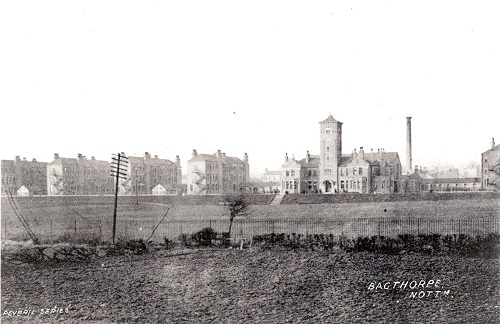
1903: Bagthorpe Workhouse and Infirmary

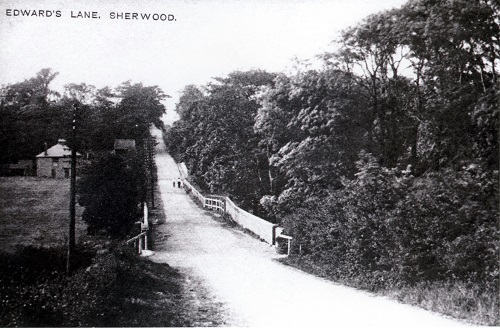
1903: Infirmary Entrance, Bagthorpe
1903: Edwards Lane
1905: Edward Parry sold Woodthorpe Grange to John Godfree Small, lace manufacturer and Mayor of Nottingham in 1917.
January 1911: Haydn Road Council School is opened.
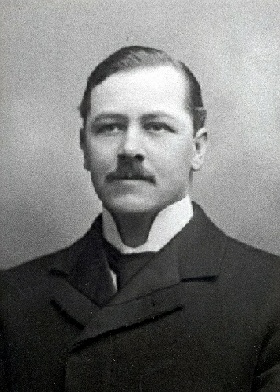
Architect, Arthur Marshall. For more historical information, click on the above image.
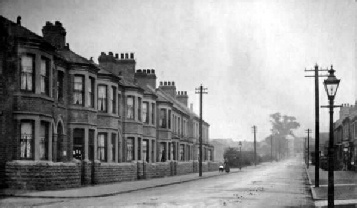
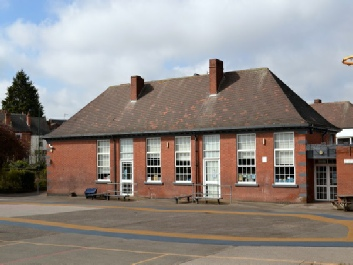
1905: Haydn Road
January 1911: Haydn Road Council School. For more historical information, click on the above image.
August 13 1913: The Kinema, Sherwood’s first cinema.


Circa 1900: Osborne Grove, Sherwood
1914/18 World War One: A war that on the Western front in France was to see 2,690,054 men become battle casualties and a further 3,528,496 succumbed to sickness and death. It was also during those four years the Bagthorpe Infirmary (Nottingham City Hospital) became a Military Hospital. The Cedars on Mansfield Road, Sherwood becomes a recuperative hospital for less serious cases with a bed capacity of 40 beds that was later increased to 50.
13th July, 1916: Partly as a wartime measure, the three stations along the Nottingham Suburban Line were closed and thereafter in terms of passenger services the line was merely a shortcut, until the end came for the Leen Valley Trains in 1931.
Nottingham’s World War One Roll of Honour
5,370 men from Nottingham lost their lives during World War One. By 1921 the city’s General Hospital was still treating 18,400 disabled servicemen. During World War One, 2,500 children from the city lost fathers during the conflict with many thousands more left grieving for brothers and other relatives.
For more historical information, click on the above

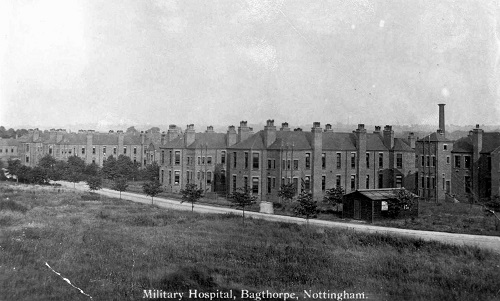
World War One, Haydn Road Soldier Recruitment
Military Hospital, Bagthorpe (City Hospital).

World War One: Wounded soldiers, Military Hospital, Bagthorpe (City Hospital)

Military Hospital, Bagthorpe (City Hospital).

1919 Housing Town and Planning Act: The 1919 Act - often known as the ‘Addison Act' after its author, Dr Christopher Addison, the Minister of Health.
The 1919 Housing Town and Planning Act was designed to address the huge demand for working-class housing in towns throughout the UK The ambitious Housing Act which promised government subsidies to help finance the construction of 500,000 houses within three years. However, as the economy rapidly weakened in the early 1920s funding had to be cut and only 213,000 homes were completed under the Act's provisions.
Dr Christopher Addison
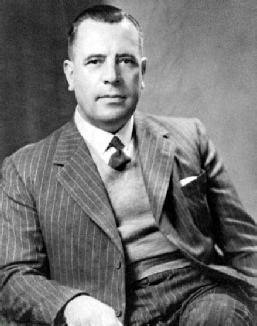
1920 to 1922: Sherwood Estate was built, the architect for the houses that were built was the architect of the Council House Thomas Cecil Howitt. After the First World War, Howitt was a keen supporter of the government’s “homes fit for heroes” building programme. The rolling, sandy land was ideal for a “Garden City”. Unlike the cramped pre-war terraces, Howitt designed spacious, houses that were spread out and designed to attract sunlight. Roads were wide and the houses set back. Open spaces were created using existing trees, also allotments surrounded by houses.
Thomas Cecil Howitt

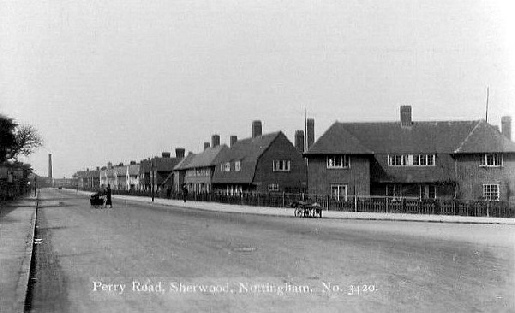
Danethorpe Vale
Perry Road

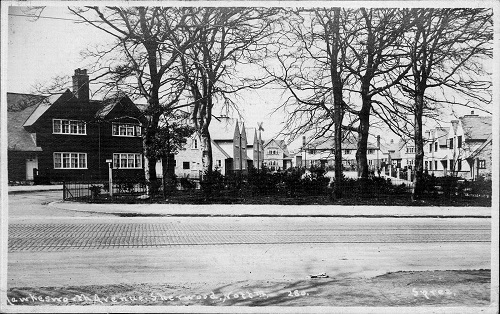
Tithby Avenue
Hawkesworth Avenue

1920’s: Garden City Hotel was opened primarily to serve the residents of the Sherwood Estate, or Garden City. It was converted from an old house called Cavendish Lodge, which belonged to Ernest Fewkes, a lace manufacturer. In later years its name was changed to The Sherwood Manor. (T.Fry, p 34)
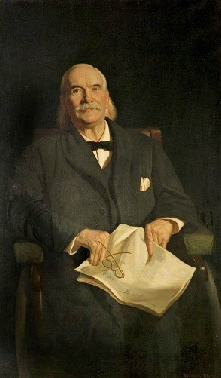
1921: Woodthorpe Grange is purchased by the Nottingham Corporation: Following a donation of £10,000 from Sir Jesse Boot the Nottingham Corporation purchased the whole of the 52-acre Woodthorpe Estate in 1921 for £15,000, which included Woodthorpe Grange with carriage drives, which are still there to this day, conservatory, glasshouses, garage, stabling and a gardener and chauffeurs’ cottages. For more information click on the image below.

Garden City/Sherwood Manor
22nd August, 1921: In celebration of the purchase of the site, the Mayor, Alderman H. Bowles and Mayoress Mrs. Bowles gave a garden party, which was held outside the Grange and amongst the invited guests was Sir Jesse Boot who in all gave £350,000 (£14.1m), which enabled the Nottingham Corporation to purchase not only the Woodthorpe Estate but also the Highfields Estate, the home of the University of Nottingham, and the park land adjacent to what became the Victoria Embankment and Memorial Gardens.
Sir Jesse Boot
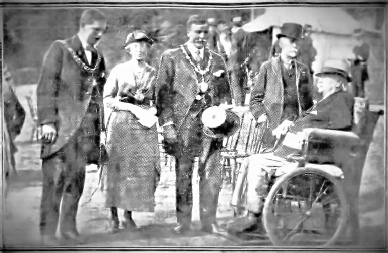
22 August, 1921: Garden party outside the Grange
1st June, 1922: Woodthorpe Park is officially opened on 1st June by the Mayor of Nottingham Councillor Mr. Frederick Berryman.

1922: Official opening of Woodthorpe Park.
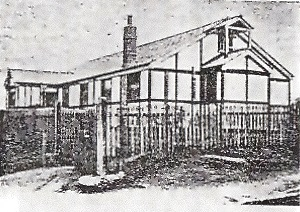
Church of the Transfiguration, the ‘Tin Tabernacle,’ Joyce Avenue, Sherwood
6th August 1922: The Feast of the Transfiguration, a few people met at a site behind the Cedars Hospital on Joyce Avenue just to hold a service proclaiming the presence of the Church in Sherwood. This was the first in the chain of events leading to the establishment of St Martin’s Church on Trevose Gardens. The initiative had been taken by Revd A. R. Browne-Wilkinson of St Paul’s in the parish of Daybrook, which then included the new Sherwood Estate.
Clearly another church and a new parish were needed, but Nottingham Corporation turned down a request for a church site on the estate. However, Colonel F. L. Seely was able to secure a plot of land behind the Cedars for a temporary church, and enough money was raised to provide a stipend for Mr P. S. Abraham to serve as Deacon and for the building of the Church of the Transfiguration. This was on Joyce Avenue. It cost almost £1,000 and it opened in 1923.
1925: Seely School was opened on Perry Road as a mixed infants and junior girls’ school. There were 275 pupils from the surrounding Sherwood Estate. In the same year saw the construction of Valley Road.

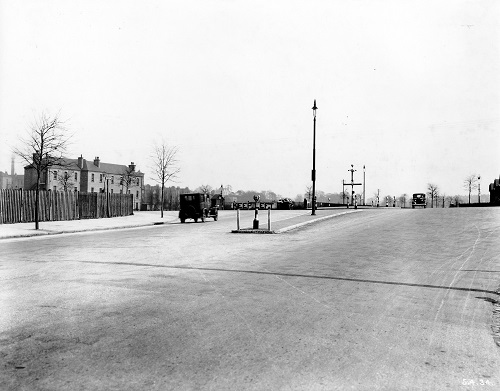
1934: Valley Road, Sherwood
1934: Valley Road at the Hucknall Road Junction.
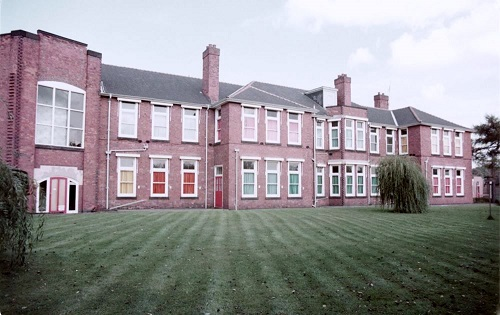
1925: The Abel Collin Trust was able to purchase a large Victorian house on the corner of Mansfield Road and Hooley Street (now Elmswood Gardens) and converted it into a 30 bedded maternity home that was opened in 1928 to both fee paying and non-fee paying patients. It was during 1946 when there was a baby boom in Nottingham that the amalgamation of the Firs with the Nottingham City Hospital’s Maternity Unit. With the construction and opening of the Queens Medical Centre in 1978 and more facilities at the City hospital, the Firs maternity hospital closed its doors on 3 January 1982 However, it was not after delivering approximately 50,000 babies in its 53 years of existence.
1982: Firs Maternity Hospital
November 1927: A temporary church was built on a plot of land on Trevose Gardens which later became the church hall for St. Martin’s Church on Trevose Gardens. Edward Lysons began his ministry in Sherwood in 1926 and dedicated himself to the task of providing a permanent church for Sherwood. The ‘Tin Tabernacle’ continued in use for Sunday Schools, until it was sold in 1944 to the Nottingham General Hospital to be used as a rehabilitation centre. It was later demolished in 1982.

Temporary Church, of St. Martin’s, Trevose Gardens
10th July, 1928: King George V and Queen visit Woodthorpe Park for a ceremony involving 17,000 children. Sherwood and Thorneywood stations were reopened on that day to enable the children and others to travel to the event.
It was during the visit to Woodthorpe Park that King George, responding to a welcoming speech by Mr William John Board, O.B.E. the Town Clerk, that he bestowed the title on Nottingham’s Chief Magistrate the title of Lord, thus entitling the Mayor of Nottingham to become the ‘Lord Mayor’ of Nottingham, a title that was bestowed on Nottingham’s first Lord Mayor, Aldermen Edmund Huntsman.
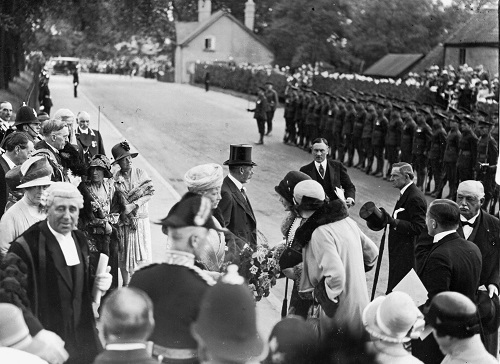
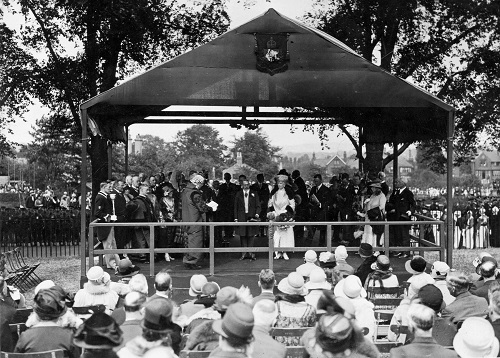
King George V and Queen Mary on Woodthorpe Drive.
King George V and Queen Mary being received by the Mayor Ald. E. Huntsman
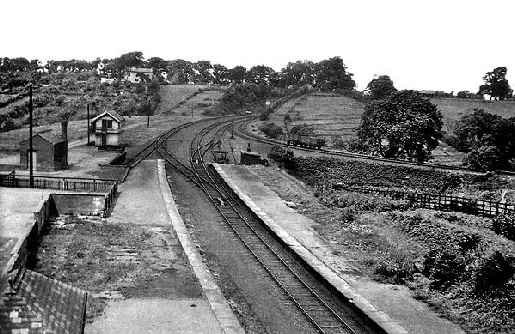
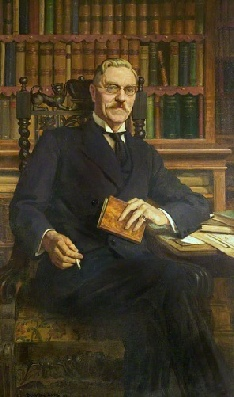
9th February, 1930: The Nottingham Suburban Railway Line becomes a single-track line with only one passenger train using the line, which ceased to operate after the 14th of September, 1931.
1938: Nottingham Suburban Railway as a single line
Ald. Edmund Huntsman

1931: Haywood Secondary Girls School was opened. Originally sharing premises with Seely School. Haywood School eventually moved to Edwards Lane in 1959 until it was closed on the 29th May, 2009.
14th December, 1935: The foundation stone for St. Martin’s Church is laid by Brigadier General Sir Edward T. Le Marchant Bart.
1931: Hayward Secondary Girls School

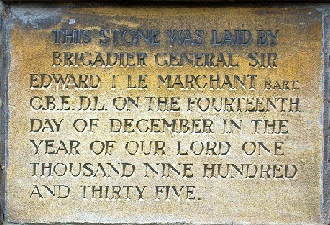
Brigadier General
Sir Edward T. Le Marchant Bart.
Foundation Stone to St. Martin’s Church

14th December, 1935: Foundation Laying Ceremony
February 1937: St. Martin’s Church on Trevose Gardens was opened. The architect was Edward Heazell and was designed in the Byzantine style. St. Martin’s Church was consecrated by the Bishop of Southwell the Right Reverend Henry Mosley on 6th February.
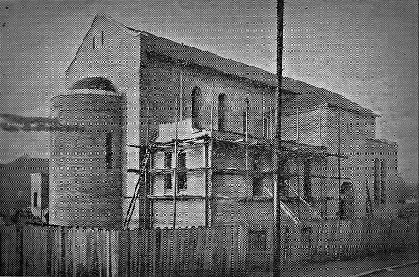


Rt. Rev. Henry Mosely Bishop of Southwell, 1928 to 1941
Architect, Edward Heazell
1936: St. Martins’ Church under construction
1936: St. Martin’s Church During Construction


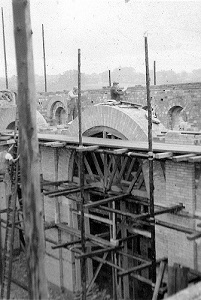
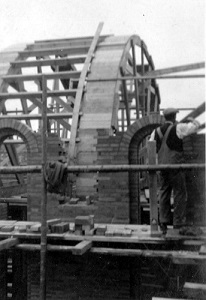

3rd August, 1937: Designed by Reginald W. Cooper, the Metropole Cinema on Mansfield Road and at the corner of Elmswood Gardens in Sherwood is opened. The Metropole was taken over by the ABC chain in 1943 and closed as a cinema on 27th October 1973. It was converted to a Bingo Club, but closed by EMI in 1979. The building was last used as a Kwik Save Supermarket, which closed around 2004 and was demolished in 2006.
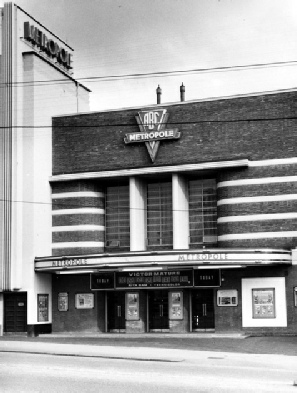

The Metropole Cinema
2nd January, 2015: After demolition it became a Somerfields Supermarket and later a Co-op. After it closed as the Co-op the building eventually became a 24 hour gymnasium.
2nd February 1939: Woodthorpe Grange’s Last Tenant Farmer, Mr. Thomas Charlesworth finally gave up his farm. With farm buildings believed to be 200 years old a decision was made by the Nottingham Corporation to further develop the park and turn part of it into a children’s play area.



Woodthorpe Farm Buildings
Circa 1960: The Barn, Woodthorpe Park
2018: The area of Woodthorpe Park where the farm buildings once stood
Sunday 3rd September 1939: World War Two is declared by the Prime Minister Neville Chamberlain.
Prime Minister Neville Chamberlain. To Listen to the PM’s announcement, click on the above illustration.
Shortly after the Prime Minister’s address to the nation an air raid warning was sounded. To hear the sound of a warning click on the air raid shelter sign.
Fortunately, the air raid warning was a false alarm so shortly after the all clear was sounded. To hear the all clear sound, click on the Rest Centre illustration.
Take Cover
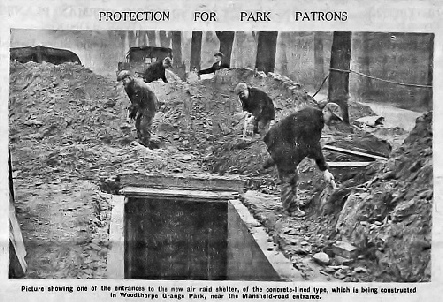

Nottingham City Hospital Air Raid Shelter construction
1939: Air Raid Shelter construction Woodthorpe Park.
30/31 August 1940: First bombs fall in Nottingham on Fairbank Crescent off Hood Street and Mapperley Street.

Mapperley Street, Sherwood
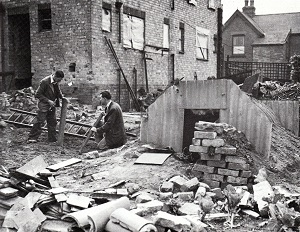
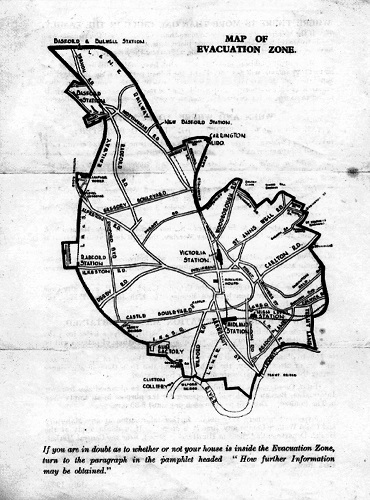
Hood Street, Sherwood
Evacuation Zone: To see a larger version, click on the above illustration
14th March, 1941: Twelve bombs are dropped on houses on Ribblesdale Road.
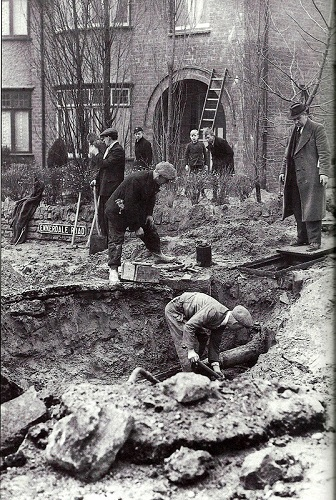

Although Nottingham was bombed on only 11 occasions, and 179 people were killed and 350 injured, the worst air raid occurred on the night of the 8th and 9th May, 1941 when 159 people including 31 children were killed and 274 injured.
Ribblesdale Road, Sherwood
Ennerdale Road, Sherwood
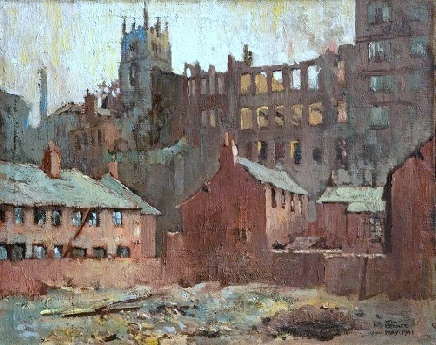
Painted after 8/9 May, 1941: “After the Blitz” near Trivett's Works from Cliff Road, Broadmarsh, Nottingham by William Benner (1884-1964). For more information, click on the above illustration.

Report from the Nottingham Evening News 9th July, 1943
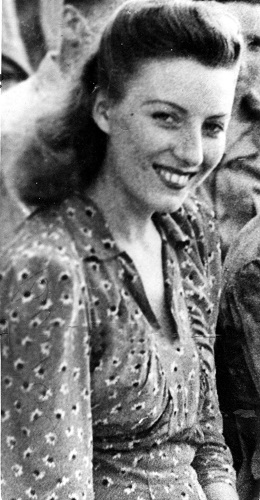
9th July, 1943: Vera Lynn, the forces sweetheart entertains soldiers recovering from injury on Lister Two Ward at the Nottingham City Hospital
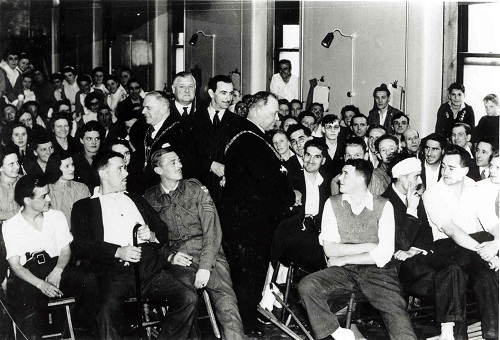
Vera Lynn
Lister Two Ward, Nottingham City Hospital, An audience eagerly awaits the arrival of Vera Lynn
8th May 1945: Victory in Europe (V.E. Day)

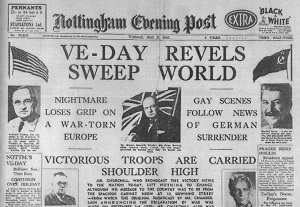
8th May 1945: V.E. Day: Crowds celebrate in Nottingham’s Old Market Square
8th May 1945: Headlines, Nottingham Evening Post
Excerpt from the Chaplains minute book, Nottingham City Hospital
The special items during this period under review have been the two special thanksgiving services for Victory in Europe, which were held on Tuesday evening, May 8th and Sunday 13th . These were united services arranged and taken by the chaplain and Mr. Evans, and were very well attended and appreciated by the staff, patients and inmates.”
To listen to the Prime Minister Winston Churchill’s Speech - The German State has surrendered on the 8th May 1945, click on the adjoining speaker box icon

15th August, 1945: Victory Over Japan (VJ DAY)
Excerpt from the Chaplains minute book, Nottingham City Hospital
Focusing during the period under review, mention must be made of the special Thanksgiving Services for War Victory (V.J.), which were held on Wednesday evening, 15th August and Sunday morning August 19th. These were attended by staff, patients and inmates, and an opportunity was thus given for expressing thanks to God in worship for the ending of the war.
20th August 1945) Mr Attlee broadcast at midnight the news that victory over Japan was complete. VJ Day coincided with the Royal Opening of Parliament and the King and Queen's drive to Westminster began the two days of celebrations. To listen and watch the speech given by the Prime Minister, click on the adjoining speaker box icon.

_______________
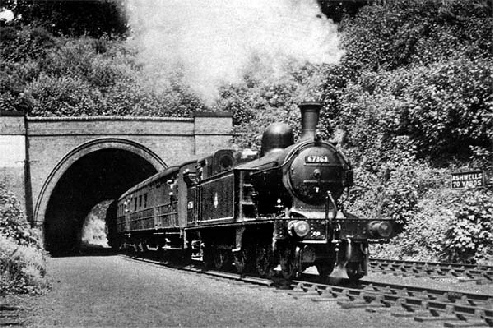
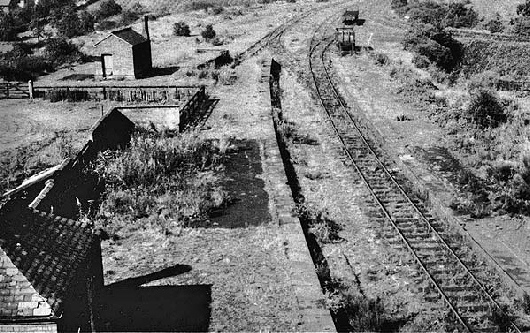
16th June, 1951: The last passenger train to be pulled on the Nottingham Suburban Railway Line.
1954: The final removal of the single line from the former Nottingham Suburban Railway.
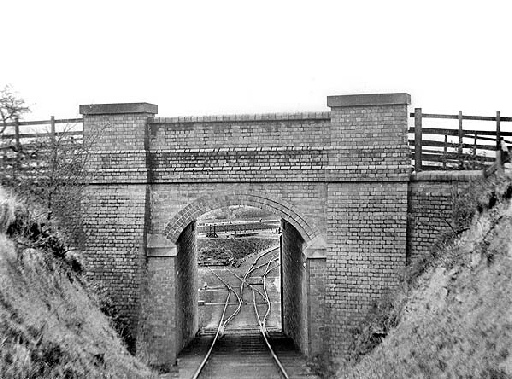
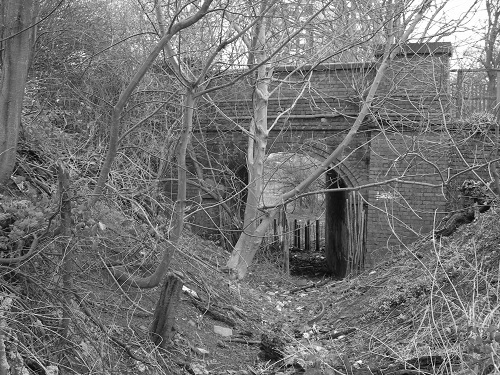
1950s: Cable assisted incline to and from the Nottingham Patient Brickworks Brick Kilns passing under Sherwood Vale
2007: Former cable assisted incline

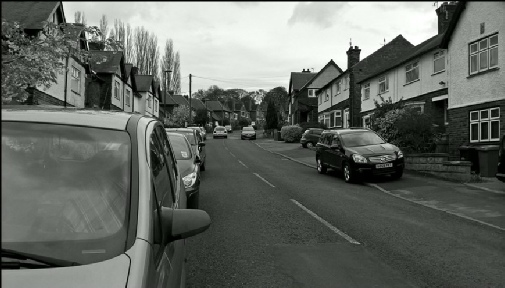
1950’s: Sherwood Vale. To read about the dark side of Sherwood Vale’s history, click on the above image.
2017: Sherwood Vale


Circa 1950’s: Mansfield Road, Sherwood
Circa 1950’s: Mansfield Road, Sherwood
Winter on Woodthorpe Grange Park
Winter of 1963: The extreme winter of 1963, also known as the ‘Big Freeze’ of 1963, was one of the coldest winters on record in the United Kingdom. The Central England Temperature series which dates from 1659, records that you have to go back to the winter of 1683-4 (months of January minus 3 C, February Minus 1 C and March 3 C) which was significantly colder, and the winter of 1739-40 – known as the ‘Great Frost’ (months of January Minus 2.8 C, February Minus 1.6 C and March 3.9 C) was only slightly colder than 1962-3.


Winter 1963: Icicles hanging from the roof of Ashwell Tunnel on the former Nottingham Suburban Railway.
1981: Woodthorpe Park
1964: Work begins on the construction of Woodthorpe and Winchester Court flats.
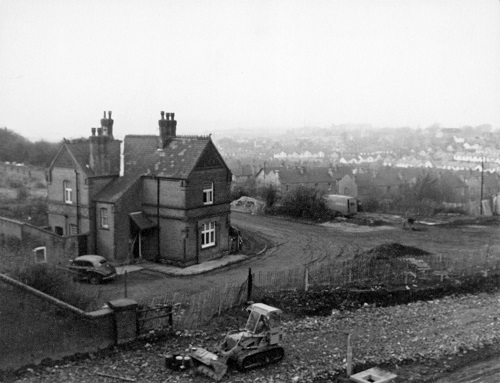
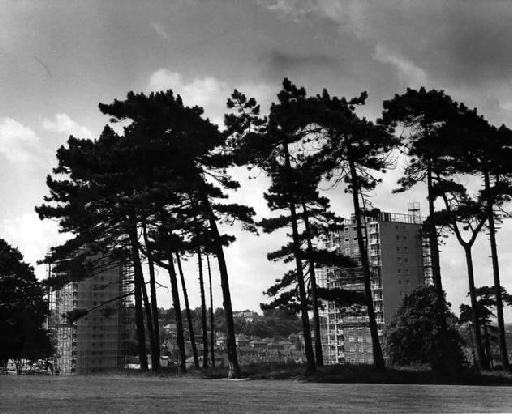
Preparation of the ground prior to construction. The house in the photograph is the former Station Masters House that was once part of Sherwood Railway Station.
Woodthorpe and Winchester Court flats under construction
1st December, 1965: Woodthorpe and Winchester Court flats officially opened by the Lord Mayor of Nottingham, Alderman William Derbyshire.

Alderman William Derbyshire


1965: From Sherwood Vale looking towards Winchester Court Flats
1965: Winchester and Woodthorpe Flats
1987: Woodthorpe and Winchester Court officially designated as housing for older people.
2017: Construction begins on a new high rise refurbishment of Woodthorpe and Winchester Court flats together with and extra care scheme, Winwood Court October, 2017.
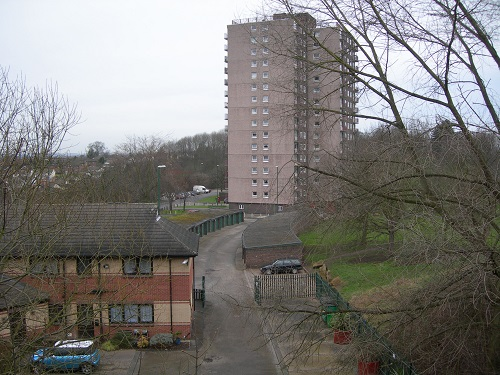
2007: From Sherwood Vale looking towards Winchester Court Flats
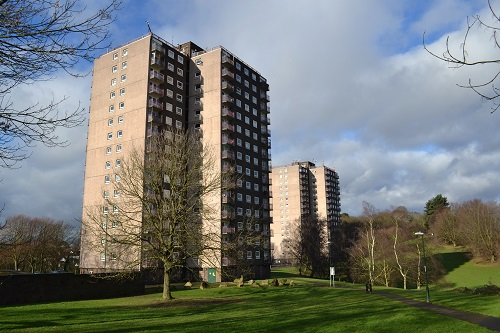
January 2017: Before renovation work had started

27 September, 2017: Construction work begins with the sinking of the foundations that in two years time will become Winwood Court

November 2017: Photograph taken from the roof of Winchester Court of the construction of Winwood Court.

2nd September, 2019: The opening ceremony to the new Winwood Court
2nd September, 2019: The brand-new facility of Winwood Court is officially opened.
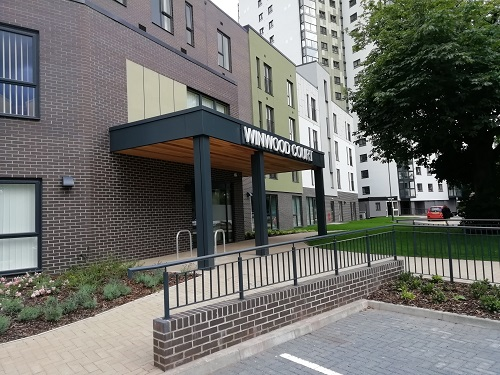
6th August, 2019: Renovation work now completed along with the construction of Winwood Court
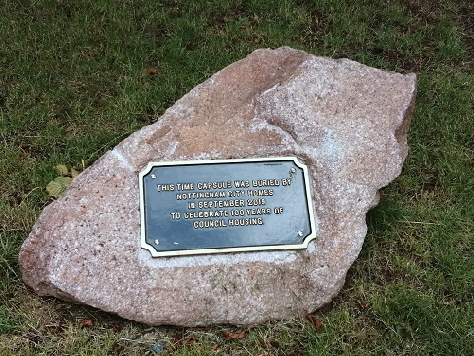
Time Capsule outside Winwood Court

1/3: Ground Floor Common Room, Winwood Court
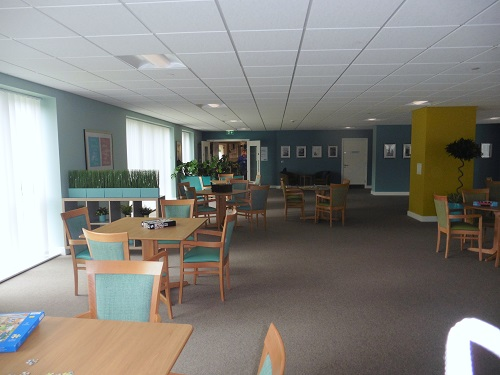
2/3: Ground Floor Common Room, Winwood Court

3/3: Ground Floor Common Room, Winwood Court
2020: Photographs taken of the unusually quiet Mansfield Road, Sherwood during the first lock down of the Covid-19 pandemic.
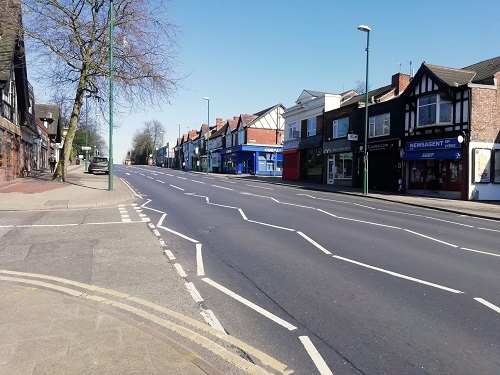
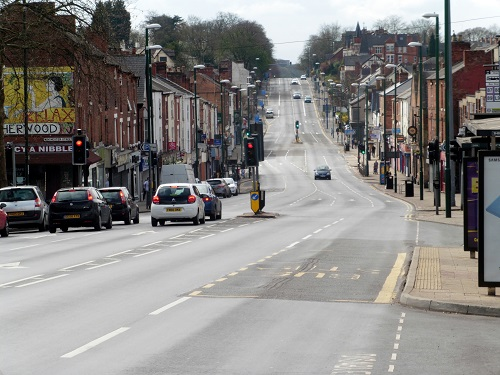
25th March, 2020: Looking up Mansfield Road from the junction of Burlington Road
4th April, 2020: Looking down Mansfield Road towards Carrington
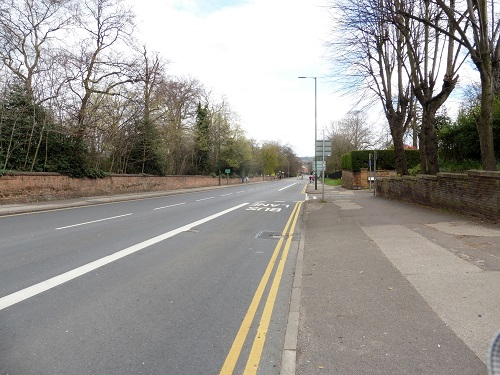
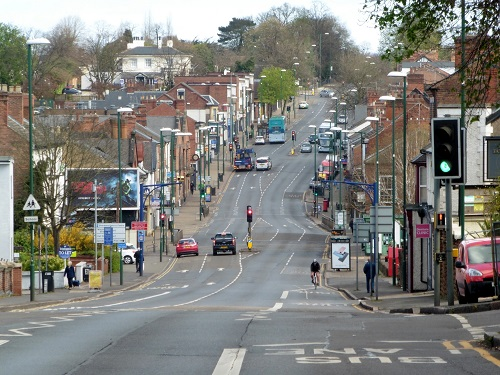
4th April, 2020: Looking Down Mansfield Road towards Daybrook
6th April, 2020: Looking down Mansfield towards Sherwood from the junction of Private Road
All Clear
For more historical information about The Cedars Convalescent Hospital, click on the above image.
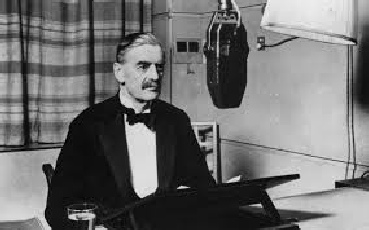


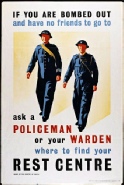

To watch a film made in 1995 entitled Nottingham at War: A City's Fight for Freedom, click on the above image
Updated: 08.05.2025.
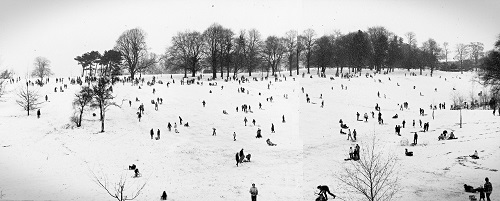
1981: Woodthorpe Park (two photographs joined together)
Later in 1871,John L. Thackeray of Arno Vale House who purchased the land a short time later sold it to Henry Ashwell a master bleacher who owned factories on Radford Road in the New Basford area of Nottingham.
1919: Brough Superior began making motorcycles in its factory on Haydn Road.
1920: 30th October, Nottingham Corporation announced the building of a new arterial road (Valley Road), from Daybrook, along the valley of the Daybrook, to Hucknall Road and then on to Fairfax Street, at a cost of £126,000. This was followed two years later in 1922 when on the 5th August Valley Road was officially opened.
10th April 1928: With a crowd of around 200 outside the prison gates, the last execution in Nottingham took place at Perry Road prison. George Frederick Hayward was hanged, by the famous Nottinghamshire hangman Thomas Pierrepont, for the murder of Derbyshire woman Amy Collinson, .